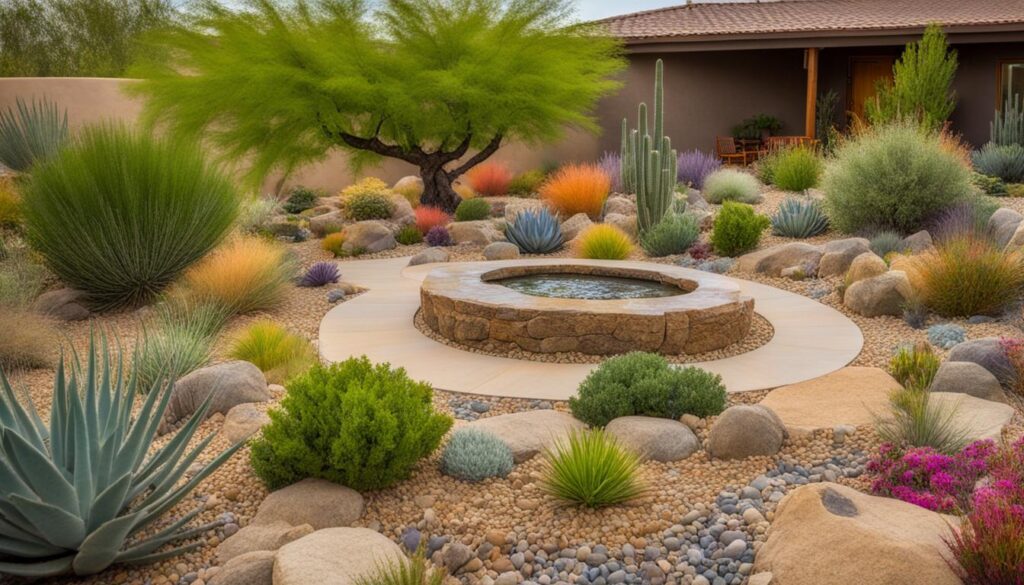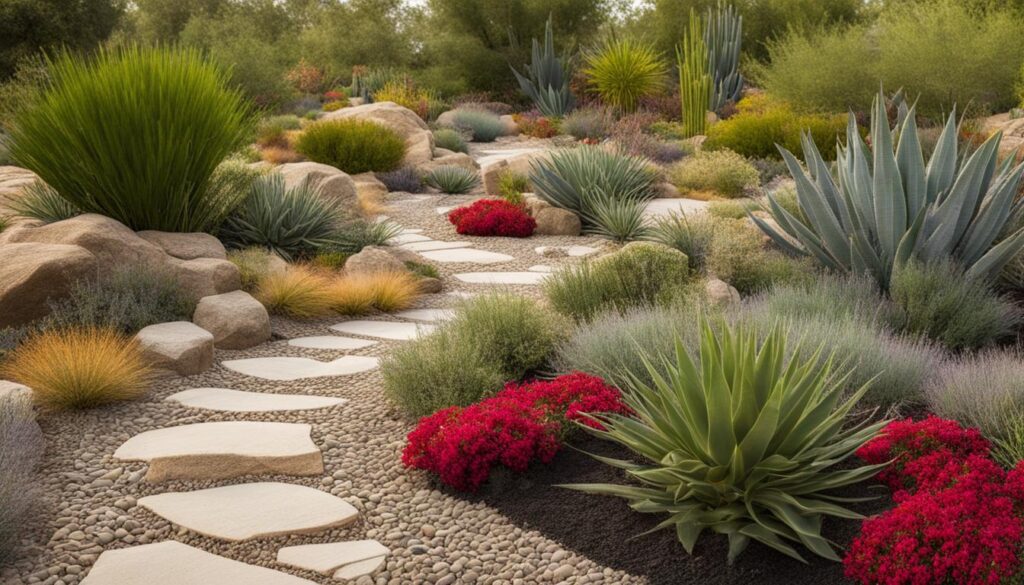Are you looking to save water, time, and create an eco-friendly outdoor space? The Green Revolution is here, and it’s all about converting your traditional lawn into a xeriscape garden. Xeriscaping is a landscaping method that focuses on using minimal water while maintaining beautiful and sustainable landscaping.
With heat waves and droughts becoming more frequent due to climate change, many homeowners are seeking ways to reduce their environmental impact and save money on water bills. By replacing your grass lawn with drought-tolerant plants, native species, rocks, and mulch, xeriscaping offers numerous benefits. Not only does it conserve water, but it also minimizes maintenance time and eliminates the use of toxic chemicals and gas-powered mowers.
Key Takeaways:
- Converting your lawn to a xeriscape garden can save water and reduce water bills.
- Xeriscaping requires less maintenance compared to traditional lawns.
- Native plants and drought-tolerant species are ideal for xeriscape gardens.
- Xeriscaping promotes biodiversity and attracts pollinators.
- By eliminating conventional lawns, you can minimize water consumption and reduce pollution.
What is Xeriscaping and Why is it Important?
Xeriscaping is a landscaping method that promotes water conservation by utilizing drought-tolerant plants and native species. It aims to create a low-maintenance and eco-friendly outdoor space. Xeriscaping is especially important in areas facing water scarcity and restrictions, such as California, where lawns use a significant amount of water. By replacing grass with plants that can thrive in the local climate without excessive watering, homeowners can conserve water resources and contribute to a more sustainable environment. Xeriscaping also reduces the need for pesticides, herbicides, and fertilizers, making it safer for humans, animals, and the overall ecosystem.
The Importance of Water Conservation
Xeriscaping plays a crucial role in water conservation. Traditional lawns demand a substantial amount of water to remain green and healthy, but in many regions, water resources are limited. By switching to drought-tolerant plants and utilizing water-saving techniques like drip irrigation, homeowners can significantly reduce their water consumption. This not only helps preserve local water sources but also reduces utility bills and the strain on water infrastructure. By adopting xeriscaping, you contribute to the responsible use of water and help mitigate the impacts of water scarcity and drought.
Preserving Native Plants and Ecosystems
Native plants are well-adapted to the local climate and require minimal resources to thrive. By incorporating native species into your xeriscape garden, you help preserve the biodiversity and ecosystem balance of your region. Native plants provide food and shelter for local wildlife, attract pollinators like bees and butterflies, and contribute to a healthier and more resilient environment. Xeriscaping encourages the use of native plants, reducing the reliance on non-native, invasive species that can outcompete and displace the local flora and fauna.
Reducing Environmental Impact
Conventional lawns have a significant environmental impact. They consume a large amount of water, contribute to air pollution through gas-powered mowers, and require the use of harmful pesticides and fertilizers. By converting your lawn to a xeriscape garden, you minimize water consumption, reduce air pollution, and eliminate the need for harmful chemicals. Xeriscaping promotes sustainability and eco-friendly practices, allowing you to create a beautiful outdoor space while minimizing your environmental footprint.
In Conclusion
Xeriscaping is a sustainable landscaping method that offers numerous benefits. By conserving water, preserving native plants, and reducing environmental impact, you can create a beautiful and eco-friendly outdoor space. The importance of xeriscaping becomes increasingly evident as we face water scarcity, climate change, and the need for sustainable practices. Start by incorporating drought-tolerant plants, utilizing efficient watering techniques, and adopting eco-friendly maintenance practices. Join the green revolution and make a positive impact on the environment by converting your lawn to a xeriscape garden.
The Benefits of Converting Your Lawn to Xeriscape
When it comes to water conservation, cost savings, reduced maintenance, and promoting biodiversity, converting your lawn to a xeriscape garden offers numerous benefits. One of the most significant advantages is the conservation of water. Xeriscaping requires significantly less water compared to traditional lawns, thanks to the use of drought-tolerant plants and efficient watering techniques. With water scarcity becoming a growing concern in many regions, reducing water usage is not only environmentally responsible but can also lead to substantial savings on your water bills.
Another benefit of xeriscaping is the reduced maintenance it requires. Say goodbye to the weekly mowing, fertilizing, and pesticide application. Xeriscape gardens are designed to be low-maintenance, allowing you to spend less time on yard work and more time enjoying your outdoor space. Plus, without the need for toxic chemicals, xeriscaping helps create a safer environment for your family and pets.
In addition to water conservation and reduced maintenance, converting your lawn to a xeriscape garden promotes biodiversity. By incorporating native plants into your landscape, you provide habitats and food sources for local wildlife. Native plants are well-adapted to the local climate and support pollinators such as bees and butterflies. As a result, your xeriscape garden can become a vibrant ecosystem, teeming with life and enhancing the overall biodiversity of your area.
How to Convert Your Lawn to a Xeriscape Garden
Converting your lawn to a xeriscape garden is a sustainable and practical way to conserve water and create a beautiful outdoor space. Here are some steps to guide you through the process:
- Xeriscape design: Start by designing your xeriscape garden. Consider the layout, focal points, and the types of plants you want to incorporate. Take into account the sun exposure and drainage of your yard to ensure the right plants thrive in each area.
- Regional plants: Choose native plants that are adapted to your region’s climate. These plants are already acclimated to the local conditions, making them more resilient and requiring less water. Research the specific plants that thrive in your area and consider their water needs, growth habits, and aesthetic appeal.
- Soil testing: Before planting, conduct a soil test to assess its composition and pH levels. This information will help you determine if any amendments are needed to optimize the soil’s health. Adding organic matter, such as compost, can improve water retention and fertility.
- Proper irrigation: Implement a watering system that minimizes water waste. Drip irrigation or soaker hoses deliver water directly to the roots, reducing evaporation and runoff. Group plants with similar watering needs together to ensure efficient watering.
- Mulching: Apply a layer of mulch around your plants to help retain moisture, suppress weeds, and regulate soil temperature. Organic mulches, such as wood chips or straw, also enrich the soil as they break down over time. Keep the mulch a few inches away from the plant stems to prevent rotting.
Converting your lawn to a xeriscape garden requires careful planning and consideration, but the benefits are well worth it. Not only will you save water and reduce maintenance, but you’ll also contribute to a more sustainable and eco-friendly environment.
Choosing the Right Plants for Your Xeriscape Garden
When it comes to creating your xeriscape garden, choosing the right plants is essential. By selecting native and drought-tolerant species, you can ensure that your garden thrives while minimizing water usage and maintenance. Here are some plant options to consider:
Drought-Tolerant Plants
- Succulents and cacti: These plants store water in their leaves and stems, making them highly adapted to arid conditions.
- Lavender: Known for its beautiful flowers and aromatic fragrance, lavender is both drought-tolerant and attracts pollinators.
- Yarrow: With its feathery foliage and colorful flowers, yarrow is a hardy perennial that requires minimal watering.
Groundcover Plants
- Creeping thyme: This low-growing herb forms a dense mat of foliage, suppressing weeds and providing a lush green cover.
- Ice plant: With its vibrant flowers and succulent leaves, ice plant is an excellent groundcover option for sunny areas.
- Creeping juniper: A tough and adaptable evergreen, creeping juniper adds texture and year-round color to your garden.
Flowering Perennials
- Black-eyed Susan: These cheerful yellow flowers attract butterflies and require little water once established.
- Purple coneflower: A popular choice for pollinator gardens, purple coneflower adds color and height to your xeriscape.
- Salvia: With its vibrant spikes of flowers, salvia is a favorite among hummingbirds and bees.
Grass Alternatives
- Buffalo grass: A native grass species, buffalo grass is drought-tolerant, low-maintenance, and provides a natural look to your landscape.
- Blue grama grass: This short, clumping grass offers excellent drought tolerance and adds a unique texture to your garden.
- Meadow foxtail: With its soft, green foliage and graceful seed heads, meadow foxtail is an attractive alternative to traditional turf grass.
By incorporating a variety of these plants into your xeriscape garden, you can create a beautiful and sustainable outdoor space that conserves water and supports local biodiversity. Remember to consider your local climate and soil conditions when selecting plants, and don’t be afraid to experiment and mix different species to create a visually appealing landscape.
Creating a Sustainable Maintenance Routine
Maintaining a xeriscape garden involves adopting sustainable maintenance practices that promote the health and longevity of your outdoor space. By incorporating organic fertilizers, natural pest control methods, proper mowing techniques, and regular maintenance, you can ensure the success of your xeriscape garden while minimizing your environmental impact.
Organic Fertilizers
When nourishing your xeriscape garden, opt for organic fertilizers instead of synthetic alternatives. Organic fertilizers provide essential nutrients without introducing harmful chemicals into the soil. They promote healthy plant growth, increase soil fertility, and contribute to a more sustainable gardening approach.
Natural Pest Control
Minimize the use of pesticides by implementing natural pest control methods in your xeriscape garden. Consider companion planting, which involves growing specific plants together to deter pests. Introduce beneficial insects like ladybugs and praying mantises, which feed on harmful pests, helping to maintain a balanced ecosystem in your garden.
Proper Mowing Techniques
When mowing your xeriscape garden, follow proper techniques that promote the health of your plants. Set the mower blades at the right height to prevent stress on the grass and encourage root growth. Leave the grass clippings on the lawn, as they act as natural fertilizer, returning valuable nutrients to the soil.
Regular Maintenance
Regular maintenance is essential for the overall well-being of your xeriscape garden. Monitor soil moisture levels to ensure plants receive adequate water without wastage. Weed regularly to prevent unwanted plants from competing for resources. Prune as needed to promote healthy growth and remove dead or diseased plant material. By staying proactive and consistent with your garden care, you can enjoy a thriving, sustainable xeriscape garden for years to come.
Can Permaculture Practices Complement a Xeriscape Garden Conversion?
Yes, permaculture and xeriscaping harmony can complement a garden conversion. By integrating water-efficient techniques and sustainable practices, such as using native plants, composting, and rainwater harvesting, a xeriscape garden can benefit from the holistic approach of permaculture, creating a more resilient and thriving ecosystem.
The Environmental Impact of Conventional Lawns
Conventional lawns may look pristine and inviting, but they come with a hefty environmental cost. One of the biggest concerns is water consumption. Traditional grass lawns require large amounts of water to stay green and healthy, contributing to water scarcity in many regions. This excessive water usage puts a strain on local water sources and exacerbates the effects of drought.
Another environmental consequence of conventional lawns is air pollution. Gas-powered lawn mowers used for regular maintenance emit harmful pollutants that contribute to air pollution and climate change. The carbon emissions from these machines further contribute to the greenhouse effect, exacerbating the ongoing environmental crisis.
Chemical runoff is another significant issue associated with conventional lawns. The use of fertilizers, herbicides, and pesticides to maintain the perfect lawn often leads to chemical runoff, which contaminates water sources and harms aquatic ecosystems. The toxins from these chemicals can have detrimental effects on the health of both humans and wildlife, further aggravating the loss of biodiversity.
“The excessive water consumption, air pollution, chemical runoff, and loss of biodiversity associated with conventional lawns are major environmental concerns.”
By converting your lawn to a xeriscape garden, you can help mitigate these environmental issues. Xeriscaping reduces water consumption by utilizing drought-tolerant plants that require significantly less watering. This conservation of water not only benefits the environment but also helps reduce your water bills. Additionally, xeriscaping eliminates the need for gas-powered mowers, resulting in reduced air pollution and a smaller carbon footprint. By embracing xeriscaping, you can play a part in creating a more sustainable future for our planet.
The Importance of Water Conservation
Water conservation is crucial in addressing the global water crisis and ensuring the availability of this vital resource for future generations. By reducing water consumption through xeriscaping, you can make a significant impact on water conservation efforts in your community. Xeriscaping not only saves water but also helps preserve the beauty and ecological balance of the natural environment. By making the switch to a xeriscape garden, you are actively contributing to a sustainable and water-wise future.
Conclusion
Converting your lawn to a xeriscape garden is a sustainable landscaping solution that offers numerous benefits. By embracing eco-friendly practices and prioritizing water conservation, you can create a beautiful outdoor space while reducing your environmental footprint. Say goodbye to excessive water consumption and hello to a more sustainable future.
With xeriscaping, you can transform your lawn into a thriving ecosystem of drought-tolerant and native plants. By choosing plants that are adapted to your local climate, you can reduce the need for excessive watering and minimize maintenance time. This not only saves you money but also helps combat water scarcity and protect the environment.
By adopting sustainable maintenance practices such as using organic fertilizers, natural pest control methods, and proper mowing techniques, you can further enhance the eco-friendliness of your xeriscape garden. These practices reduce chemical runoff, air pollution, and the loss of biodiversity, contributing to a healthier and more sustainable outdoor space.
So, take the first step towards a more sustainable future by converting your lawn to a xeriscape garden. Embrace the beauty of native plants, the efficiency of smart irrigation, and the satisfaction of knowing that you are making a positive impact. With sustainable landscaping practices, you can create a vibrant, water-conserving, and eco-friendly oasis right in your own backyard.














